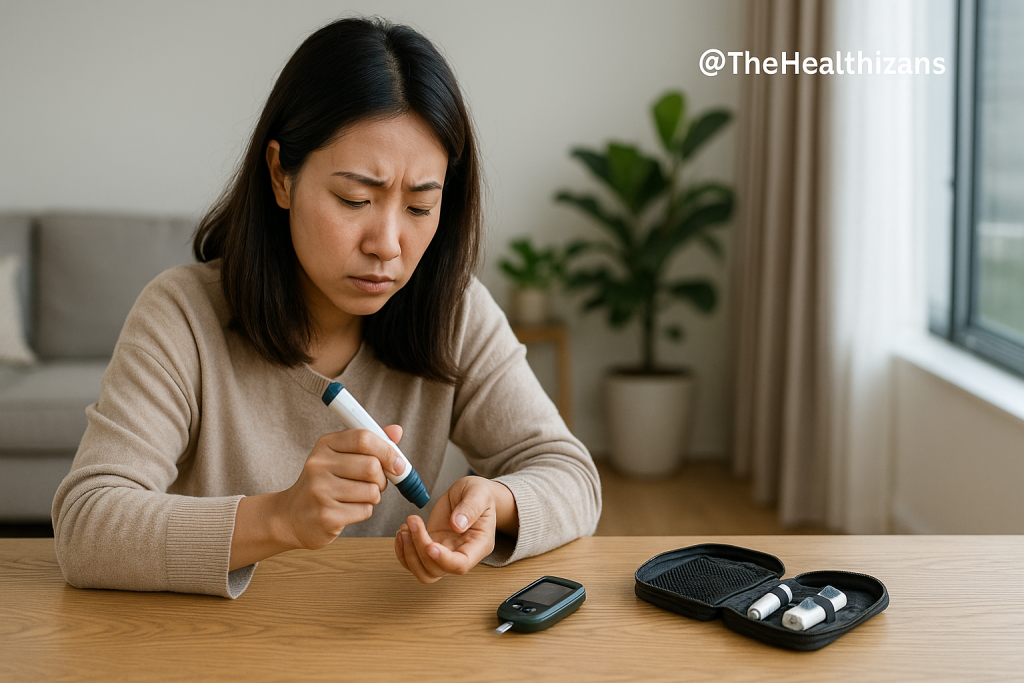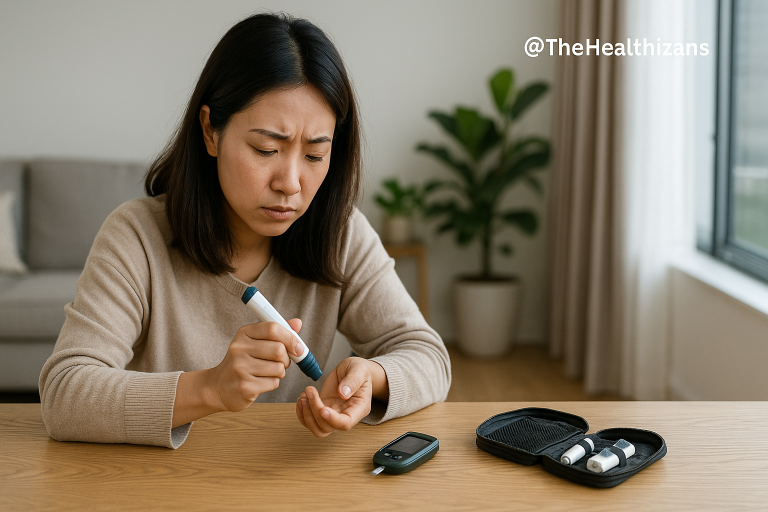
🩸 What’s All the Fuss About Blood Sugar?
You’ve probably heard the term “blood sugar” thrown around — especially if you or someone close to you is managing diabetes. But here’s the truth: blood sugar matters to everyone. Whether you’re in Lagos, London, or Kuala Lumpur, your body relies on a delicate glucose balance to function at its best.
From energy crashes to serious complications, understanding your blood sugar — and keeping it in check — is one of the smartest health moves you can make.
🔬 What Is Blood Sugar, Anyway?
Blood sugar (or blood glucose) refers to the amount of sugar circulating in your bloodstream. This sugar comes primarily from the carbohydrates you eat — like bread, rice, fruit, and sugary drinks.
Here’s what happens:
- You eat a meal.
- Your digestive system breaks carbohydrates into glucose.
- Glucose enters your bloodstream.
- Insulin, a hormone from your pancreas, helps move that glucose into your cells.
- Your cells use the glucose for energy — powering your brain, muscles, and organs.
If insulin isn’t working properly (or not enough is produced), glucose builds up in your blood instead of being used. Over time, this can cause serious damage.
❤️ Why Does Blood Sugar Matter?
Keeping blood sugar within a healthy range protects your:
- 🔋 Energy levels — avoiding sudden crashes or fatigue
- 🧠 Cognitive function — high or low glucose can impair concentration and mood
- ❤️ Heart health — excess glucose contributes to arterial damage and inflammation
- 👁️ Vision — poorly managed glucose increases risk of retinopathy
- 🧠 Nervous system — reducing the risk of neuropathy and stroke
- 🧪 Hormonal balance and metabolism
Globally, rising blood sugar levels are a key contributor to the increase in non-communicable diseases (NCDs). The World Health Organization estimates that diabetes directly caused 1.5 million deaths in 2019 — with many more indirectly from complications like heart disease and kidney failure.
📊 What’s a Healthy Blood Sugar Range?
| Blood Sugar Level (Fasting) | Meaning |
|---|---|
| Below 70 mg/dL (3.9 mmol/L) | Low (Hypoglycaemia) |
| 70–99 mg/dL (3.9–5.5 mmol/L) | Normal |
| 100–125 mg/dL (5.6–6.9 mmol/L) | Prediabetes |
| 126 mg/dL+ (7.0 mmol/L+) | Diabetes (diagnosed) |
📌 Note: After meals, a healthy blood sugar level is usually below 140 mg/dL (7.8 mmol/L) after 2 hours.
🧪 How to Check Your Blood Sugar
Monitoring your blood glucose helps you catch changes early and take action. Here’s how you can check it — even from home:
🧰 1. Using a Glucometer (Finger-Prick Test)
- Step 1: Wash your hands
- Step 2: Insert a test strip into the glucometer
- Step 3: Use the lancet to prick the side of your fingertip
- Step 4: Place a drop of blood on the test strip
- Step 5: Wait for the reading (usually within 5–10 seconds)
➡️ Ideal for people with diabetes or prediabetes to monitor trends daily.
📱 2. Continuous Glucose Monitor (CGM)
- A small sensor is worn on the arm or abdomen
- It measures glucose in real-time and sends data to your smartphone or reader
- No finger-pricking needed for each check
➡️ Recommended for people with insulin-treated diabetes, especially those with type 1.
🕐 When Should You Check?
| First thing in the morning | Gives fasting blood sugar baseline |
| Before meals | Helps guide portion control and meal choices |
| 2 hours after eating | Shows how food affects your glucose |
| Before/after exercise | Especially important if you take insulin |
| Before bed | Ensures levels are stable overnight |
⚠️ If you’re unsure how often to check, speak to your GP, pharmacist, or diabetes nurse.
⚡ What Affects Blood Sugar?
Blood glucose fluctuates naturally during the day — but certain factors can spike or drop it rapidly:
- 🍛 What you eat – Especially sugary snacks, refined carbs, and large meals
- 🏃 Exercise – Regular movement helps your body use glucose more efficiently
- 🧠 Stress – Raises cortisol, which can increase blood sugar
- 🌙 Sleep – Poor sleep makes your body more insulin-resistant
- 💊 Medications – Especially steroids, beta-blockers, or insulin
- 🤒 Illness or infections – Often cause temporary spikes
🚨 Spotting the Signs of Imbalance
When your blood sugar dips too low (hypoglycaemia) or spikes too high (hyperglycaemia), you may notice:
- Shakiness or sweating
- Brain fog or confusion
- Irritability or mood swings
- Increased hunger or thirst
- Frequent urination
- Fatigue or blurred vision
- Dizziness or fainting
⏳ The Long-Term Risks of Poor Blood Sugar Control
Over time, high blood sugar can silently damage your:
- ❤️ Heart – Increased risk of heart attack and stroke
- 🧠 Brain – Increased risk of vascular dementia
- 👁️ Eyes – Diabetic retinopathy is a leading cause of blindness
- 🧍 Nerves – Can lead to pain, tingling, or loss of sensation (neuropathy)
- 👣 Feet – Poor wound healing can lead to infections and even amputation
- 🧪 Kidneys – Leading to chronic kidney disease or failure
🛡️ So, What Can You Do?
You don’t have to wait for a diagnosis. Protecting your blood sugar starts with everyday habits:
- 🍠 Choose complex carbs (whole grains, beans) over refined sugars
- 🚶 Walk after meals to help stabilise your levels
- 🛏️ Prioritise 7–8 hours of sleep nightly
- 📏 Eat smaller, balanced meals throughout the day
- 🧘♀️ Practice stress management — yoga, breathing, nature time
- 🧪 Get regular check-ups — especially if you have family history
🌍 The Bottom Line
Blood sugar isn’t just a diabetes issue — it’s a global health priority. Whether you’re trying to stay energised at work, reduce your chronic disease risk, or improve your mood, learning to manage your glucose is a life-changing investment.
Stay curious. Stay balanced. Stay well.
✨ And don’t forget to follow @TheHealthizans for more tips on food, movement, and prevention.
📚 References
- World Health Organization (2023). Diabetes. https://www.who.int/news-room/fact-sheets/detail/diabetes
- American Diabetes Association (2024). Standards of Medical Care in Diabetes – Executive Summary
- NHS UK (2023). Understanding blood sugar levels
- Mayo Clinic (2023). Blood sugar testing: Why, when and how
- International Diabetes Federation (IDF). Global Diabetes Overview 2023



